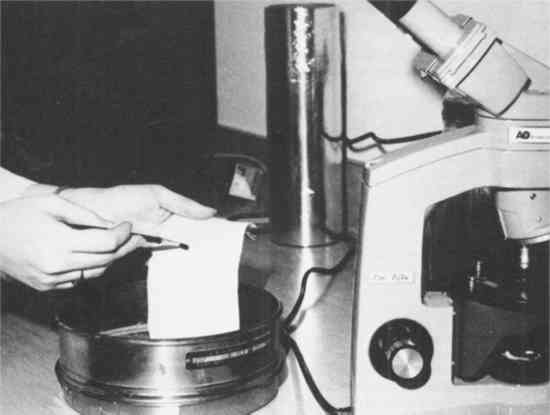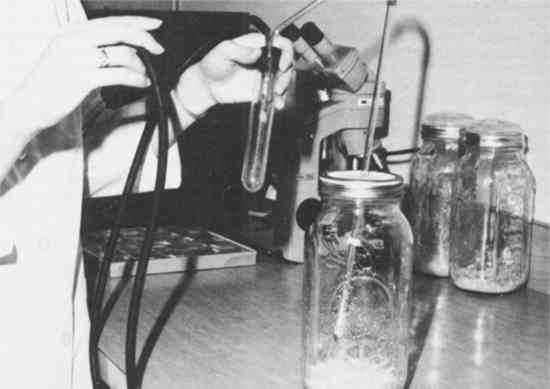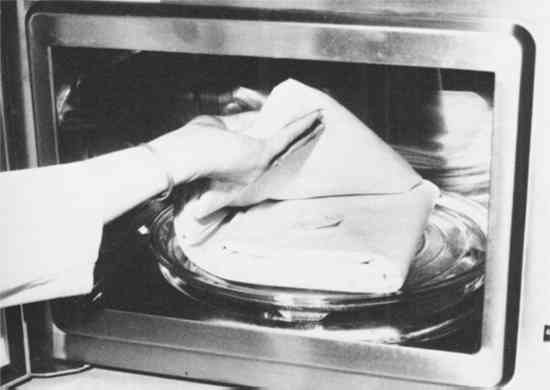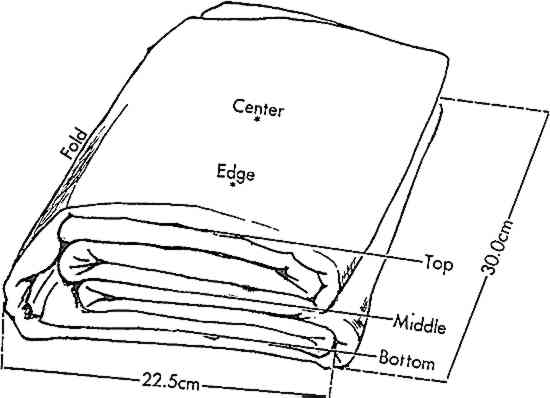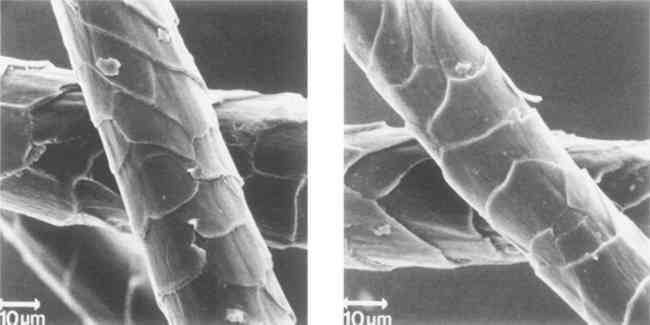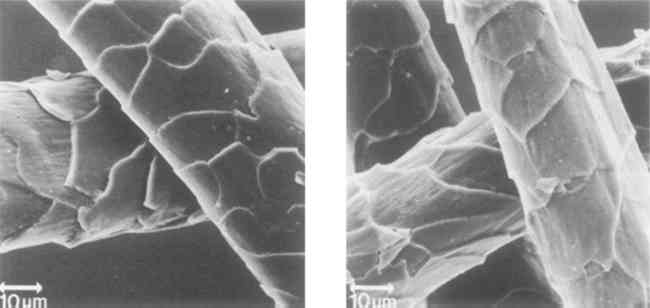ERADICATION OF INSECTS FROM WOOL TEXTILESBarbara M. Reagan
1 Part II Eradication By Microwave Irradiation: An Experimental Method1.1 INTRODUCTIONClothes moths, carpet beetles, and other fabric pests usually are eradicated and controlled by insecticidal chemicals that are often toxic, polluting, and cause deterioration and discoloration in textiles. A recent publication on pest control practices in museums stated that additional research is needed to develop safe and effective nonchemical methods of controlling insect growth.1 Extreme variations in temperature have been used to a limited extent to disinfest textiles. For example, subjecting textiles to temperatures below freezing (i.e., − 18�C for 4 hours or 0�C for several days) can be effective in killing fabric pests.2 An alternative, nonchemical method of disinfesting textiles is microwave irradiation. Applying microwaves to textiles is not new. Microwave heating has been used to a limited extent in the textile industry for drying, dyeing, and finishing textiles.3–11 Microwave disinfestation also is not new. Since World War I, the feasibility and cost-effectiveness of killing insects with electromagnetic radiation have been explored.12 Gamma, microwave, and radiowave frequencies have been used in the agricultural and food processing industries to control insect growth in wheat, flour, stored grain, and cereal products and to eradicate wood-boring insects in timber.13–16 Advantages of microwave and radiowave disinfestation include speed, efficiency, and the absence of toxic, hazardous or polluting residues.17, 18 Also, insects are not likely to develop a resistance to radiation as they often do to chemical insecticides. In Australia, for example, clothes moths had developed a tolerance to dieldrin, a widely used mothproofing agent that is no longer available in the United States.19, 20 The microwave absorbing potentials of the insect and of the host or infested material determines the effectiveness of the treatment. The efficacy of microwave disinfestation depends on the physical, chemical, and dielectrical properties of the material and insect and the output and frequency of the radiation.21 Host materials containing no polar groups and little or no moisture generally do not absorb microwaves. Microwave absorption produces heat by increasing the vibrational activity of the molecules. The lethal effect in insects is attributed to the heat generated in the host material and in the insect's body, but certain nonthermal effects have been reported.22 Microwave exposure also can result in abnormal development, prolonged pupation, and shorter adult life in insects, as reported for mealworms irradiated with microwaves.23 Because the radiation-absorbing qualities of the host material and of the insect may differ, one may heat faster than the other.24, 25 The type, particle size, compactness, and moisture content of the host material as well as the type, developmental stage, and species of the insect influence the effectiveness of microwaves.26 Nelson27 reported that microwave disinfestation was more effective in killing rice weevils in wheat as the moisture content of the wheat was increased. In several studies, it was necessary to heat the host material to a temperature that was lethal to the insect to obtain 100% kill.28 The chief purpose of radiation-disinfestation treatments is to kill insects economically and effectively without harming the host material.29 Previous research by Reagan, Chiao-Cheng, and Streit30 showed that 2450 MHz microwave radiation can be used to disinfest wool textiles. Four minutes of microwave exposure was effective in killing (100%) the egg, larval, and adult stages of the webbing clothes moth on small wool samples (4.5 � 4.5 cm) with no significant color change in 93 acid and natural dyes commonly used on wool fabrics. Research was continued to determine if longer exposure times were needed to disinfest larger wool samples (i.e., 2.2 m) and is reported here. In assessing the potential of using microwave radiation for disinfesting wool textiles, I also evaluated the effects of microwave radiation on selected physical and chemical properties of new and old wool fabrics. Specific tests performed on the new wool included breaking strength, elongation, shrinkage, moisture regain, color change (yellowing), and alkali solubility. Breaking strength, elongation, and alkali solubility tests were performed on the old wool. Because of the limited sample size, shrinkage and moisture regain tests were not conducted on the old wool samples after microwave irradiation. Color change was not evaluated on the old wool because the samples had been dyed. Scanning electron micrographs were taken of fiber specimens from both new and old wool samples before and after they were irradiated with microwaves to determine if any surface changes might have occurred in the fibers after treatment. 1.2 EXPERIMENTAL PROCEDURES1.2.1 Materials1.2.1.1 InsectsWebbing clothes moths, Tineola bisselliella (Humm.), obtained from the Stored-Products Insects Research and Development Laboratory, Savannah, Ga., were reared according to the procedures in AATCC Test Method 24-1977, Resistance of Textiles to Insects.31 Insect cultures were prepared by placing newly emerging moths from the stock cultures into 2-quart Mason jars containing Moth Test Cloth (Testfabrics, Inc.) fortified with brewer's yeast. After 3 days, the moths were removed and transferred to other jars for further egg laying. The Moth Test Cloth containing the newly deposited eggs was removed from the jars and gently brushed with a soft-bristled brush to dislodge the eggs as shown in Figure 1 The eggs were passed through a No. 40 U. S. standard sieve to separate them from larger, extraneous matter, and then 10 each were placed in small bags consisting of a 5 � 5 cm swatch of transparent cellulose film and Moth Test Cloth, sewn together on three sides 0.5 cm from the edge. After the eggs were placed in the fabric/film bag, its open end was closed with transparent tape.
The larvae and adult moths, 10 each, also were placed in individual fabric/film bags. Experiments were carried out on larvae approximately 40–43 days old as measured from the date of egg deposition. Newly emerging moths were collected in a glass vial fitted with a rubber-stoppered, suctioning device (see Figure 2). Before the moths were transferred to the fabric/film bags, they were temporarily immobilized by placing the vial in a beaker of ice water. The fabric/film bags, containing the moths were set aside approximately one hour before microwave exposure.
1.2.1.2 Wool FabricsA worsted, 100% wool gabardine (Style #522, Testfabrics, Inc.) with a fabric count of 29 � 19 per cm and fabric weight of 407 g/m2 was used in the experiments for determining the lowest level of microwave raidation lethal to the egg, larval, and adult stages of the webbing clothes moth. It also was used in assessing the effects of microwave radiation on the physical and chemical properties of new wool. In addition, two 100% wool fabrics dating from c. 1916 were irradiated with microwaves and evaluated for changes in alkali solubility and tensile properties to determine if aged fabrics were more susceptible than new wool to damage by microwaves. Both of these fabrics were taken from swatch cards used for advertising purposes. The sample designated Fabric A was a 2/2 worsted wool gabardine with a fabric count of 22 � 14 per cm. Fabric B was a plain weave, wool flannel with a fabric count of 22 � 13 per cm. Both old wools had a fabric weight of 203 g/m2. Prior to microwave irradiation and performing the various physical and chemical tests, all fabrics were conditioned in a standard atmosphere for testing (70 � 2�F and 65 � 2% relative humidity) for 24 hours. 1.2.2 Method1.2.2.1 Insect Exposure to Microwave RadiationThe egg, larval, and adult stages of the webbing clothes moth were exposed within a 2.2 m sample of wool gabardine that weighed 832.4 g to determine the time required to disinfest the amount of cloth used in an “average” wool garment. The wool gabardine samples were conditioned for 24 hours and then folded so that the final dimensions of each were 22.5 � 30.0 cm. The fabric/film bags containing the insects were placed singly between the folds in the wool gabardine with an equal amount of fabric above and below. The top layers of the fabric were arched slightly so that the weight of the fabric would not crush the
Mortality counts on the eggs were made 30–40 days after microwave exposure. 1.2.2.2 Fabric TemperatureThe temperature of the 2.2 m wool gabardine samples during microwave exposure was monitored with temperature-sensitive strips (Tempilabels�, Omega Engineering, Inc.) to determine the evenness of microwave heating within the fabrics and to evaluate the effects of microwave irradiation on the properties of wool. The Tempilabels� contain a series of dots corresponding to different temperatures. The center of the dots will darken if the temperature associated with a specific dot has been reached. A series of Tempilabels� were placed at the following locations within the 2.2 m wool gabardine samples: top-edge, top-center, middle-edge, middle-center, bottom-edge, and bottom-center (see Figure 4). Temperatures were recorded after 1, 6, and 10 repeated 3-minute exposures and after 10 minutes of continuous exposure. The 3-minute period of exposure represented the time necessary to kill the egg, larval, and adult stages of the webbing clothes moth. Temperatures after 10 minutes of continuous exposure were recorded to assess the effects of prolonged microwave irradiation on wool.
Additional tests performed on the 2.2 m samples used for determing fabric temperatures included shrinkage, color change, moisture regain, alkali solubility, and tensile properties. These samples were not used in the previous experiments in which the lethal dosage of microwave radiation was ascertained. After each 3-minute exposure, 25 � 25 cm samples were cut from the middle section of the larger 2.2 m wool samples, replaced by unexposed samples to maintain a constant sample weight, and conditioned for further testing. Two replicates were tested at each microwave exposure level. 1.2.2.3 Fabric ShrinkageTo determine whether or not microwave irradiation caused fabric shrinkage, five sets of 25.4 � 25.4 cm reference squares were randomly marked on each of the 2.2 m samples of wool gabardine. After irradiating the samples with microwaves for 1, 6, or 10 3-minute periods or for 10 minutes, they were reconditioned and the reference markings were measured at the corners and midpoint of each square, in both the warp
where: A = original distance between reference marks, and B= final distance between reference marks. 1.2.2.4 Color ChangeThe color of the undyed wool gabardine before and after microwave irradiation was evaluated visually and instrumentally with a Hunterlab D25M-4 tristimulus colorimeter. A Tektronix 31 programmable calculator, which interfaced with the optical processor on the colorimeter, converted CIE tristimulus values (X, Y, and Z) into CIE 1976 L∗a∗b∗ uniform color solid coordinates, and calculated total color difference, ΔE. Six readings were averaged for each sample (top-edge, top-center, middle-edge, middle-center, bottom-edge, and bottom-center positions), within each treatment (1, 6, and 10 3-minute exposures and one 10-minute exposure) and replication. 1.2.2.5 Moisture RegainProceedures in ASTM D 629–77, Quantitative Analysis of Textiles,32 were used for determining the amount of moisture in the wool gabardine before and after microwave exposure. Three specimens, each measuring 7.6 � 7.6 cm, were cut from the control and microwave irradiated samples (25.4 � 25.4 cm squares removed from the 2.2 m samples). All specimens were conditioned for 24 hours, weighed, heated in a Precision Scientific Company, Model 17 laboratory oven at 110 � 2�C for one hour, and then placed in a desiccator for 4 days to ensure that all residual moisture had been removed. The dried specimens were then reweighed, and moisture regain was calculated by using the following equation:
where: A = air-dry weight of specimen, g, and B= oven/desiccator-dry weight of specimen, g. 1.2.2.6 Tensile PropertiesChanges in tensile properties are one of the most widely used methods for investigating the effects of thermal treatments on fiber properties. In this study, breaking strength and elongation tests were conducted on warp yarns taken from the 25.4 � 25.4 cm samples of wool gabardine after microwave irradiation (1, 6, and 10 3-minute exposures and one 10-minute exposure). The unexposed controls also were tested. Breaking strength and elongation tests were performed on yarns taken from the filling direction in the old fabrics. Because of the limited fabric, the old wools were tested only before and after 10 minutes of microwave irradiation. The old wool fabric samples were placed between the center folds of a 2.2 m sample of wool gabardine during exposure to maintain the same mass of fabric used in testing the new wool. Procedures in ASTM D 2256, Standard Test Method for Breaking Load (Strength) and Elongation of Yarn by the Single-Strand Method,33 were followed by 1.2.2.7 Alkali Solubility of WoolThe method described by Earland and Raven34 was used to determine the amount of wool soluble in a 0.100 N solution of sodium hydroxide. Fabric samples weighing approximately 1 g were cut from the control and microwave-irradiated wool (25.4 � 25.4 cm sample removed from the larger 2.2 m sample), conditioned, and then unraveled. The unraveled yarns were cut into 1 cm lengths, placed in 250 ml beakers, oven-dried at 110 � 2�C for one hour, and then placed in a desiccator overnight. Specimens weighing approximately 0.5 g were removed from each beaker and weighed to the nearest 0.001 g. The weighed specimens were transferred to a 250 ml of 0.100 N sodium hydroxide at 65 � 0.5�C. The flasks were stoppered and placed in a Tamson, Model TCV 40, constant temperature bath set at 65 � 0.5�C and shaken gently every 10 minutes for 60 minutes. The contents of the flasks were then transferred to separate, preweighed sintered glass crucibles. The flasks were washed thoroughly in distilled water and emptied into the crucible. The collected material was washed six times with distilled water (55 ml each), once with acetic acid (30 ml of a 0.5% solution), and then given six aditional rinses with distilled water (55 ml each), by using gentle suction to drain the solution after each rinse. Next, the treated specimens were dried in an oven (110 � 2�C) for 3 hours, placed in a desiccator overnight, and then weighed to the nearest 0.001 g. The alkali solubility of the specimen was calculated as follows:
where: W1 = mass of oven-dry specimen before NaOH treatment, and W2= mass of oven-dry specimen after NaOH treatment. 1.2.2.8 Scanning Electron Microscopy (SEM)The surface characteristics of fibers taken from the new and old wool fabrics before and after 10 minutes of microwave exposure were examined by an ETECH Scanning Electron Microscope. Specimens irradiated for 3 minutes were not evaluated because previous tests indicated that the changes in these specimens were minimal. Fiber specimens randomly selected from the unexposed and exposed samples were prepared for SEM analysis by mounting them on specimen holders with a conductive paste and coating with a thin layer of carbon and gold-palladium (60–40). 1.2.2.9 Statistical AnalysisData obtained from the shrinkage, color difference, moisture regain, breaking strength, elongation, and alkali solubility tests were analyzed statistically by using a general linear model and analysis of variance procedure. The Duncan's Multiple Range Test was performed on the data if F was significant in the previous two tests. The level of confidence used in all statistical tests was 0.05. 1.3 RESULTS1.3.1 Insect MortalityMortality percentages for the egg, larval, and adult stages of the webbing clothes moth after 0.5, 1.0, 1.5, 2.0, 2.5, 3.0, 4.0, and 5.0 minutes of microwave irradiation are presented in Table I. Three replicates of 10 insects each were tested at each exposure time and developmental stage of the insect. TABLE I Mortality of Egg, Larval, and Adult Stages of the Webbing Clothes Moth Exposed to 2450 MHz Microwave Radiation for Different Exposure Times. In general, mortality percentages associated with the egg, larva, and adult webbing clothes moth progressively increased as microwave exposure time increased. Compared with the larval and adult stages, a higher percentage of eggs was killed by low levels of microwave exposure (0.5, 1.0, and 1.5 minutes), but longer exposure times were needed for 100% mortality in the egg stage. Also, a percentage of egg mortality would occur normally without irradiation; Rawle35 reported the average mortality of unexposed eggs to be approximately 25%, but considerably fewer of our unexposed controls died. The times required to obtain 100% mortality in the egg, larva, and adult clothes moth were 3.0, 2.0, and 2.0 minutes, respectively. Hence, 3.0 minutes of microwave exposure was sufficient to kill all three stages of the insect in a 2.2 m sample of wool gabardine. The moth or adult stage of the insect was the least resistant to microwave radiation. As noted in Part I, susceptibility of insects to chemical and nonchemical methods of control is frequently influenced by the stage of the insect. The egg, larva, and adult clothes moth were killed more quickly when exposed between a 2.2 sample of wool gabardine than when exposed in the Bradley No. 3 polystyrene boxes as reported in our earlier study.36 Wool normally has a high moisture content; in this case, the additional steam generated by the moisture in the larger (2.2 m) wool samples greatly facilitated disinfestation. 1.3.2 Temperature of Irradiated WoolThe average temperatures attained in the 2.2 m wool samples at the six designated locations during microwave exposure, as measured with the heat-sensitive Tempilabels�, are presented in Table II. The initial 3-minute period of microwave exposure resulted in temperature ranges of 62� to 76�C for the six positions monitored within the samples. Repeated 3-minute periods of microwave exposure produced similar temperature ranges. The continuous 10-minute exposure resulted in significant higher temperature ranges of 103� to 149�C. Domestic microwave ovens often produce uneven heat, so variations in temperature within the 2.2 m wool samples were not unexpected. TABLE II Temperature of Wool Gabardine (2.2 m sample) Exposed to 2450 MHz Microwave Radiation. The temperatures of the top-center (TC) and top-edge (TE) positions in the wool samples exposed continuously for 10 minutes were considerably lower than those recorded at other locations. In the samples exposed to microwaves for 3 minutes, both initially and after 10 repeated exposures, the highest temperatures were recorded at the middle-edge (ME) positions. Slightly lower temperatures were attained in the middle-center (MC) positions where the insects were placed during testing. Thus, the exposure conditions recommended for microwave disinfestation are 3 minutes of continuous exposure with a minimum internal sample temperature of 69�C. In selecting a method of insect control for historic as well as contemporary textiles, a major concern is the effects of the treatment on the item. If wool is heated in dry air above 100�C for an extended time, it loses its moisture, the fiber may become harsh, and yellowing and decomposition may occur, resulting in the evolution of hydrogen sulfide and ammonia.37 In an excellent paper on the thermal behavior of textiles (1,436 references), Slater38 reviews conduction, convection, and radiation heating methods, including electromagnetic energy sources, in terms of efficiency, advantages, disadvantages, and industrial applicability. Cloth temperatures below 105�C are considered safe for 1.3.3 Effects of Microwave Radiation on Selected Physical and Chemical Properties of WoolIn selecting a method of insect control for textiles, a major concern is the effects of the treatment on the physical and chemical properties of the fabric. Tests used in this study to assess the safety and viability of microwave irradiation as a nonchemical method of insect control on wool were shrinkage, color change, moisture regain, alkali solubility, tensile properties, and visual fiber characteristics as viewed by scanning electron microscopy. Wool gabardine samples (2.2 m) were irradiated with microwaves for 3 minutes (time required to produce 100% kill) and 10 minutes. The 3-minute treatments were repeated 10 times so that the effects of successive exposures could be evaluated. Samples were evaluated after 10 minutes of exposure to determine if accidental or prolonged microwave heating was detrimental to wool. Because of the limited sample size, the only tests performed on the historic (c. 1916) wool fabrics were yarn breaking strength and elongation, alkali solubility of wool, and SEM analysis. The effects of microwave exposure on acid dyes and natural dyes commonly used on wool were evaluated in a previous study.39 1.3.3.1 Fabric ShrinkageThe average lengthwise and widthwise shrinkage (%) values for the 2.2 m wool samples are given in Table III. One 3-minute exposure resulted in 0.33% and 0.05% shrinkage in the lengthwise and widthwise fabric directions, respectively. No significant increase in shrinkage occurred after 6 or 10 repeated 3-minute exposures. The small amount of shrinkage that occurred in these samples could have been relaxation shrinkage, because the wool gabardine was not steamed, pressed, or washed prior to irradiation. TABLE III Shrinkage of Wool Gabardine (2.2 m sample) Exposed to 2450 MHz Microwave Radiation. Compared with the samples exposed repeatedly to microwaves for 3 minutes, the 2.2 m wool samples exposed continuously for 10 minutes exhibited significantly more shrinkage in both the lengthwise and widthwise fabric directions. Thus, prolonged periods of microwave exposure may result in excessive fabric shrinkage and should be avoided. 1.3.3.2 Color ChangeThe average total color difference for the wool fabrics exposed 1, 6, and 10 times to microwave radiation for 3 minutes ranged from 0.16 to 0.87 ΔE units. For the samples irradiated continuously for 10 minutes, the color difference values were slightly higher, ranging from 0.49 to 1.06 ΔE units (see Table IV). When evaluated visually, however, there was no perceivable color change or yellowing in any of the test specimens irradiated 3 minutes. A slight yellowing was observed in the specimens irradiated continuously for 10 minutes. All color difference values were less than that which corresponded to a step 4–5 (slightly stained) rating on the AATCC Gray Scale for Staining (4–5 rating = 2.3 � 0.3 ΔE (CIELAB) units). Color difference values for the AATCC Gray Scales cannot be used to judge precisely the amount of color change in a test specimen, however. TABLE IV Total Color Difference (ΔE) for Wool Gabardine (2.2 m samples) Exposed to 2450 MHz Microwave Radiation. Even though color change could not be perceived visually in the samples that were irradiated continuously for 10 minutes, the highest ΔE values were obtained in those areas of the 2.2 m samples that exhibited the highest temperatures. Thus, prolonged or excessive microwave heating may cause discoloration in wool. 1.3.3.3 Moisture RegainThe wool gabardine samples irradiated with microwaves for 3 minutes and 10 minutes had slightly lower moisture regain values after exposure, but the differences were not statistically significant (see Table V). In this study, moisture regain was evaluated because water absorption in wool is related to the number of polypeptide and amino groups in the fiber. Chemical decomposition may alter the absorption properties of wool if the functional groups are appreciably changed. In addition, the brittleness of a fiber increases as moisture regain decreases. Results of this study showed that microwave irradiation did not cause a significant change in the absorption properties of wool. TABLE V Moisture Regain Values for Wool Gabardine (2.2 m samples) Exposed to Microwave Radiation. 1.3.3.4 Tensile StrengthNo significant change occurred in the breaking strength and elongation of the warp yarns taken from the new wool gabardine irradiated repeatedly for 3 minutes, with intermittent cooling and conditioning, or continuously for 10 minutes. The old wool fabrics dating 1916 also exhibited no significant change in strength and elongation after 10 minutes of continuous microwave exposure (see Table VI). These results agreed with those previously reported.40 TABLE VI Breaking Strength and Elongation of Yarns from Wool Gabardine and Old Wool (c. 1916) Exposed to 2450 MHz Microwave Radiation. 1.3.3.5 Alkali Solubility of WoolThe solubility (%) of wool in a 0.100 N sodium hydroxide solution is a sensitive and convenient quantitative test for assessing the extent to which wool has been damaged during processing (i.e., bleaching, chlorination, light exposure, etc.).41 When the peptide, disulfide, or hydrogen bonds in keratin are ruptured, the solubility of wool usually increases. Zahn and W�rz42 reported the alkali solubility values for wool samples heated and also treated with a variety of chemical agents. Alkali solubility data for the new wool and old wool fabrics before and after microwave irradiation are given in Table VII. The solubility of the untreated wool gabardine sample was 17.01%. The one 3-minute exposure to microwaves resulted in a 5% decrease in alkali solubility, but repeated 3-minute exposures and the continuous 10-minute exposure increased the percentage of wool soluble in the sodium hydroxide solution. These increases ranged from 8 to 16%. Results from the Duncan's Multiple Range Test showed that all levels of microwave exposure produced significant changes in the percentage solubility of the wool gabardine; there was, however, no significant difference between the mean solubilities for the samples exposed continuously for 10 minutes or repeatedly to six 3-minute exposures. The greatest increase in alkali solubility occurred in the samples that were irradiated with microwaves for 10 3-minute treatments. TABLE VII Alkali Solubility Values for Wool Gabardine and Old Wool (c. 1916) Exposed to 2450 MHz Microwave Radiation. The alkali solubility data corresponded with the breaking strength data in that decreases in solubility resulted in increases in breaking strength and vice versa. For example, the wool gabardine samples exposed to microwave radiation for one 3-minute period exhibited a 3.3% increase in breaking strength and a 5% decrease in solubility; whereas the sample irradiated 10 times exhibited a 7% decrease in strength and a 16% increase in solubility, which were the highest mean values obtained in each test. Old wool Fabric A exhibited only a 2% increase in alkali solubility after 10 minutes of microwave irradiation, whereas old wool Fabric B exhibited a 3% decrease in solubility. Thus, less change occurred in the solubility of the old wool specimens after irradiation, compared with that of the new wool. This may be attributed to the dyes and finishes on the fabric or the previous history of the old wool samples. 1.3.3.6 Scanning Electron MicroscopyRepresentative specimens from the new wool gabardine and old wool fabrics (c. 1916) before and after 10 minutes of continuous microwave irradiation are shown in Figures 5–7. As mentioned previously, the old wool fabrics were taken from swatch cards used in advertising and thus had not been subjected to repeated wearings or launderings through consumer use. The scale structure and surface characteristics of the old wool fibers were similar to the fibers taken from the new wool gabardine.
Fiber specimens from the new and old wool fabrics were examined after 10 minutes of microwave heating to determine if prolonged periods of irradiation resulted in surface defects or damage. If changes were observed in the fiber after 10 minutes of exposure, additional analyses would have been conducted on fibers irradiated for 3 minutes; however, no changes were observed in the surface characteristics of the new and old wool fibers after 10 minutes of exposure, as shown in Figures 5–7, right-side images. The fiber surfaces had well-defined, undamaged scales; and no cracks, splits, or other defects were apparent. 1.4 CONCLUSIONSIf prudently administered, microwave heating can provide a safe and effective, nonchemical method of disinfesting wool textiles. In this study, 3 minutes of microwave exposure was sufficient to obtain a 100% mortality in the egg, larval, and adult stages of the webbing clothes moth in a 2.2 m sample of wool gabardine with minimal effects on the chemical and physical properties of wool. Prolonged periods of microwave heating should be avoided, however, as wool may suffer degradation at temperatures above 100�C. Ten minutes of microwave irradiation, which represented prolonged heating in this study, produced internal fabric temperatures of 149�C and caused an increase in alkali solubility, shrinkage and color change when compared with the unexposed samples or those irradiated for 3 minutes. Before using any chemical or nonchemical method of eradication on textiles, especially those that have historical significance, the past history and condition of the item must be carefully assessed. Microwave disinfestation may be suitable for wool ACKNOWLEDGEMENTSI thank Annie Cheng and Kari Arnold, Research Assistants, Department of Clothing, Textiles and Interior Design; and Marian Massoth, Extension Assistant, Pesticide Impact Assessment, for their assistance in collecting data on pesticide formulations. The technical assistance of Mr. Martin Dannatt, CPO, Schendel Pest Control, Manhattan, Kansas, also is appreciated. |
